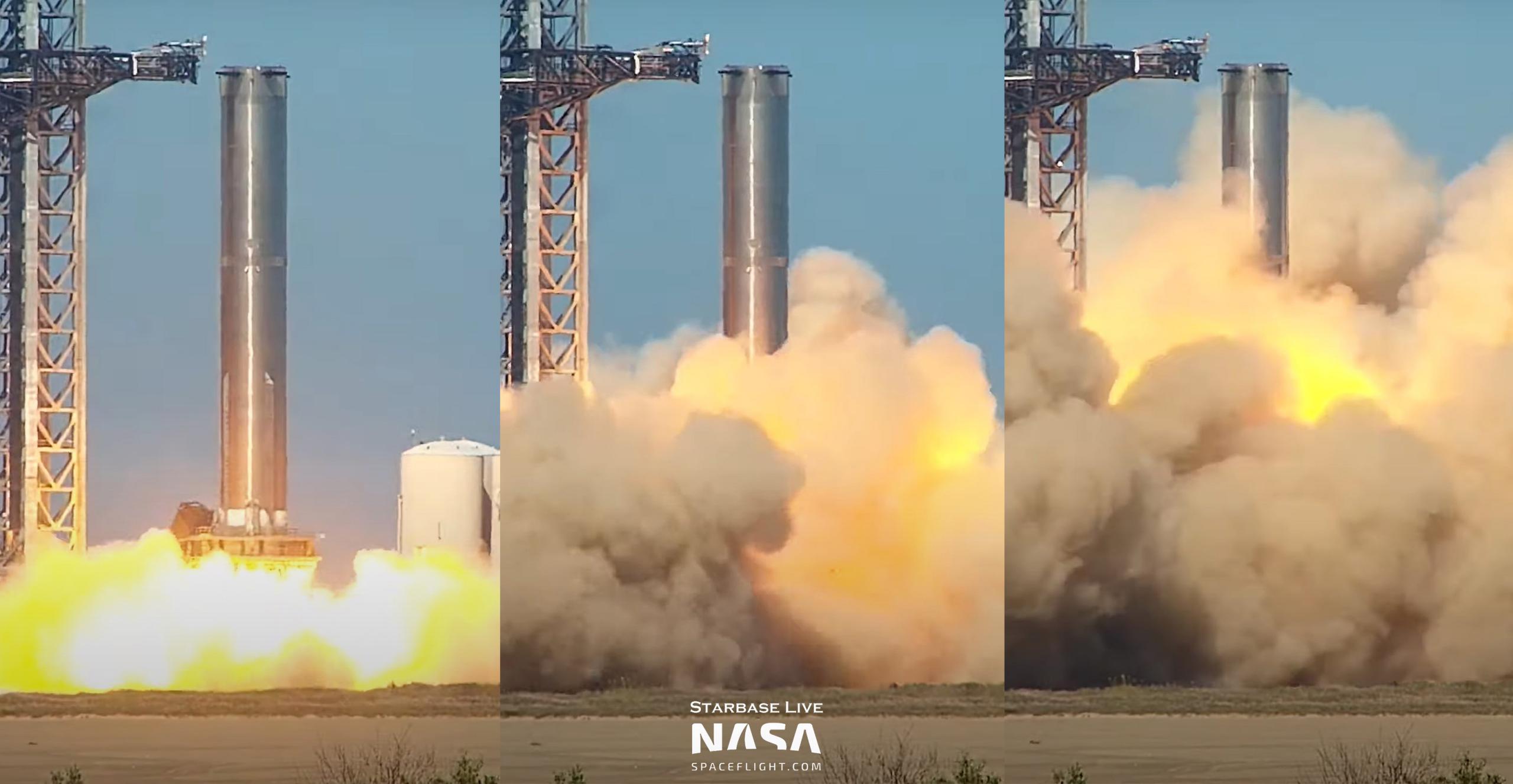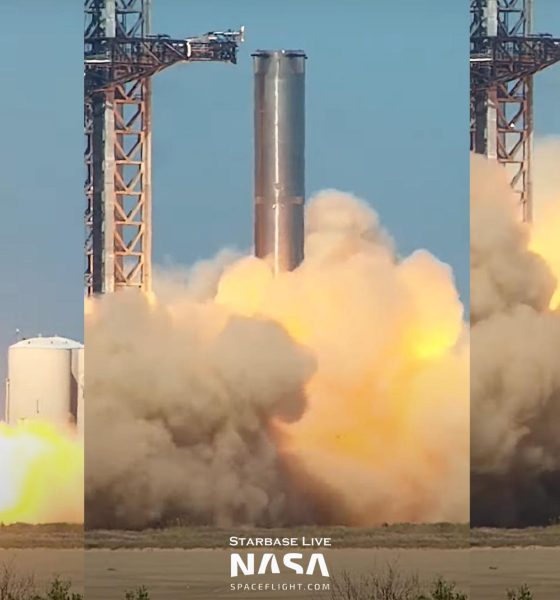

News
SpaceX’s Starship briefly becomes the most powerful active rocket in the world
A SpaceX Starship booster has successfully fired up 14 of its 33 Raptor engines, likely becoming the most powerful active rocket in the world.
Throughout the history of spaceflight, only three or four other rockets have produced as much or more thrust than Super Heavy Booster 7 (B7) could have theoretically produced on November 14th. But the Soviet Energia and N1 rockets and the US Saturn V and Space Shuttle were all retired one or several decades ago. Only SpaceX’s own Falcon Heavy rocket, fifth on the bracket and capable of producing up to 2325 tons (5.13 million pounds) of thrust at sea level, is still operational and comes close.
Powered by 33 upgraded Raptor 2 engines that SpaceX says can produce up to 230 tons (~510,000 lbf) each, Super Heavy could have produced up to 3220 tons (7.1 million pounds) of thrust when it ignited 14 of its engines earlier today. That likely means that Starship is now the fourth most powerful rocket ever tested, slotting in above NASA’s Space Shuttle but below the Soviet Energia. And even if all 14 engines never throttled above 73%, SpaceX’s Starship booster likely still produced more thrust than any other active rocket in the world, beating Falcon Heavy. But if NASA has its way, Starship could hold that title for less than 36 hours.
As early as 1:04 am EDT (06:04 UTC) on November 16th, a little over 35 hours after SpaceX’s record-breaking Starship static fire, NASA will attempt to launch its massive Space Launch System (SLS) rocket for the third time since late August. At the explicit request of Congress, which wanted to preserve Shuttle jobs after the end of the program in 2011, SLS essentially shuffles around Space Shuttle parts and replaces the reusable orbiter with a fully-expendable rocket. The Solid Rocket Boosters (SRBs) have been extended and uprated, and the orange External Tank has been stretched and turned into a liquid rocket booster affixed with four RS-25 engines to the Shuttle’s three.
If things go according to plan, those changes mean that SLS rocket will produce up to 3990 tons (8.8 million pounds) of thrust when it lifts off for the first time, overtaking Super Heavy B7 but also making it the second most powerful launch vehicle in history after the Soviet N1. N1 never succeeded, however, so SLS could become the most powerful rocket ever to reach orbit if its first launch is successful.
But just as SLS appears poised to almost immediately unseat Starship’s position as the most powerful active rocket in the world, Starship is poised to beat SLS to become the most powerful rocket ever flown – successfully or not – when it attempts its first orbital launch either next month or early next year. With all 33 Raptors at full throttle, Starship can produce almost 7600 tons (16.7 million pounds) of thrust at liftoff, beating the previous record-holder – the Soviet N1 rocket – by nearly 60%.
Even if that first launch attempt is unsuccessful, SpaceX appears to be preparing for several more rapid-fire launches that will continue until success is achieved, beating SLS’ other (potential) record. SpaceX has demonstrated that ability once before with Starship when it completed five flights of five different prototypes in less than six months. As a result, it’s likely that by the time SLS launches a second time in the mid-2020s, it will be the third most powerful rocket, second to N1 and Starship.
That slightly awkward upset should be lessened by the fact that Starship and SLS are, for the time being, both integral parts of NASA’s Artemis Program. To return astronauts to the Moon for the first time since 1972, SLS and its Orion spacecraft will transport NASA astronauts to lunar orbit, where they’ll board a Starship-derived Moon lander. Starship will then land those astronauts on the lunar surface, support about a week of surface operations, and then return them to lunar orbit, where Orion will transport them back to Earth.
For now, a massive amount of work remains to be done before NASA and SpaceX will be ready to support that crewed Moon landing. But Monday’s Starship static fire and Wednesday’s potential SLS launch both represent significant, tangible steps towards that lofty goal.

News
Tesla FSD fleet is nearing 7 billion total miles, including 2.5 billion city miles
As can be seen on Tesla’s official FSD webpage, vehicles equipped with the system have now navigated over 6.99 billion miles.

Tesla’s Full Self-Driving (Supervised) fleet is closing in on almost 7 billion total miles driven, as per data posted by the company on its official FSD webpage.
These figures hint at the massive scale of data fueling Tesla’s rapid FSD improvements, which have been quite notable as of late.
FSD mileage milestones
As can be seen on Tesla’s official FSD webpage, vehicles equipped with the system have now navigated over 6.99 billion miles. Tesla owner and avid FSD tester Whole Mars Catalog also shared a screenshot indicating that from the nearly 7 billion miles traveled by the FSD fleet, more than 2.5 billion miles were driven inside cities.
City miles are particularly valuable for complex urban scenarios like unprotected turns, pedestrian interactions, and traffic lights. This is also the difference-maker for FSD, as only complex solutions, such as Waymo’s self-driving taxis, operate similarly on inner-city streets. And even then, incidents such as the San Francisco blackouts have proven challenging for sensor-rich vehicles like Waymos.
Tesla’s data edge
Tesla has a number of advantages in the autonomous vehicle sector, one of which is the size of its fleet and the number of vehicles training FSD on real-world roads. Tesla’s nearly 7 billion FSD miles then allow the company to roll out updates that make its vehicles behave like they are being driven by experienced drivers, even if they are operating on their own.
So notable are Tesla’s improvements to FSD that NVIDIA Director of Robotics Jim Fan, after experiencing FSD v14, noted that the system is the first AI that passes what he described as a “Physical Turing Test.”
“Despite knowing exactly how robot learning works, I still find it magical watching the steering wheel turn by itself. First it feels surreal, next it becomes routine. Then, like the smartphone, taking it away actively hurts. This is how humanity gets rewired and glued to god-like technologies,” Fan wrote in a post on X.
News
Tesla starts showing how FSD will change lives in Europe
Local officials tested the system on narrow country roads and were impressed by FSD’s smooth, human-like driving, with some calling the service a game-changer for everyday life in areas that are far from urban centers.

Tesla has launched Europe’s first public shuttle service using Full Self-Driving (Supervised) in the rural Eifelkreis Bitburg-Prüm region of Germany, demonstrating how the technology can restore independence and mobility for people who struggle with limited transport options.
Local officials tested the system on narrow country roads and were impressed by FSD’s smooth, human-like driving, with some calling the service a game-changer for everyday life in areas that are far from urban centers.
Officials see real impact on rural residents
Arzfeld Mayor Johannes Kuhl and District Administrator Andreas Kruppert personally tested the Tesla shuttle service. This allowed them to see just how well FSD navigated winding lanes and rural roads confidently. Kruppert said, “Autonomous driving sounds like science fiction to many, but we simply see here that it works totally well in rural regions too.” Kuhl, for his part, also noted that FSD “feels like a very experienced driver.”
The pilot complements the area’s “Citizen Bus” program, which provides on-demand rides for elderly residents who can no longer drive themselves. Tesla Europe shared a video of a demonstration of the service, highlighting how FSD gives people their freedom back, even in places where public transport is not as prevalent.
What the Ministry for Economic Affairs and Transport says
Rhineland-Palatinate’s Minister Daniela Schmitt supported the project, praising the collaboration that made this “first of its kind in Europe” possible. As per the ministry, the rural rollout for the service shows FSD’s potential beyond major cities, and it delivers tangible benefits like grocery runs, doctor visits, and social connections for isolated residents.
“Reliable and flexible mobility is especially vital in rural areas. With the launch of a shuttle service using self-driving vehicles (FSD supervised) by Tesla in the Eifelkreis Bitburg-Prüm, an innovative pilot project is now getting underway that complements local community bus services. It is the first project of its kind in Europe.
“The result is a real gain for rural mobility: greater accessibility, more flexibility and tangible benefits for everyday life. A strong signal for innovation, cooperation and future-oriented mobility beyond urban centers,” the ministry wrote in a LinkedIn post.
News
Tesla China quietly posts Robotaxi-related job listing
Tesla China is currently seeking a Low Voltage Electrical Engineer to work on circuit board design for the company’s autonomous vehicles.

Tesla has posted a new job listing in Shanghai explicitly tied to its Robotaxi program, fueling speculation that the company is preparing to launch its dedicated autonomous ride-hailing service in China.
As noted in the listing, Tesla China is currently seeking a Low Voltage Electrical Engineer to work on circuit board design for the company’s autonomous vehicles.
Robotaxi-specific role
The listing, which was shared on social media platform X by industry watcher @tslaming, suggested that Tesla China is looking to fill the role urgently. The job listing itself specifically mentions that the person hired for the role will be working on the Low Voltage Hardware team, which would design the circuit boards that would serve as the nervous system of the Robotaxi.
Key tasks for the role, as indicated in the job listing, include collaboration with PCB layout, firmware, mechanical, program management, and validation teams, among other responsibilities. The role is based in Shanghai.
China Robotaxi launch
China represents a massive potential market for robotaxis, with its dense urban centers and supportive policies in select cities. Tesla has limited permission to roll out FSD in the country, though despite this, its vehicles have been hailed as among the best in the market when it comes to autonomous features. So far, at least, it appears that China supports Tesla’s FSD and Robotaxi rollout.
This was hinted at in November, when Tesla brought the Cybercab to the 8th China International Import Expo (CIIE) in Shanghai, marking the first time that the autonomous two-seater was brought to the Asia-Pacific region. The vehicle, despite not having a release date in China, received a significant amount of interest among the event’s attendees.








